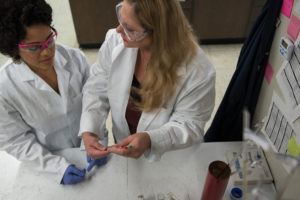Kim Renee Dunbar Discusses the Future Potential of 3D Bioprinting in the Medical Industry


Renowned Inorganic Chemist and Texas A&M Professor Kim Renee Dunbar relays how bioprinting may be ready for mainstream use sooner than predicted.
Kim Renee Dunbar is a celebrated chemist and professor who has made significant contributions in coordination chemistry and molecular magnetism during her career. A respected international leader in science, she explains below how 3D bioprinting may be a feasible solution for countless patients in the near future.
“Once thought to only be an element of science fiction storylines, doctors and physicians around the world may soon be able to rely on fabricated organs created through 3D bioprinting,” says Kim Renee Dunbar. “This marks one of the highest achievements of modern science as it can offer a life-saving medical resource to myriad patients and potentially extend the average length of life.”
3D bioprinting is made possible by using cells and other biocompatible materials in the form of bioink to print layers of substance that behaves as natural living systems and can be combined into functioning organs. Today, specialists take a digital model of a structure, such as skin tissue or bone, and recreate it with bioink that is either seeded with cells after creation or mixed in with existing living cells. Models can be created from various sources, such as generated programs, a CT, or an MRI scan, and stored digitally for future use.
“There are tens of thousands of patients in America alone who are waiting for organ transplants, and it means the difference between life and death for many,” says Kim Renee Dunbar. “In addition, many patients who receive organ transplants experience lasting damage from the effects of post-transplant immunosuppression.”
In the past, there have been a handful of significant hang ups preventing 3D-bioprinting from becoming a feasible solution for physicians. However, with recent scientific breakthroughs, industry professionals like Kim Renee Dunbar believe we’re very close to broader implementation of bioprinted organs.
“One of the major barriers to progress in 3D bioprinting was capillaries, which are required before any organ can function properly,” says Kim Renee Dunbar.
A company founded in 2016 is the pioneer behind a recent capillary breakthrough in 3D-printed organs with research scientists Melanie Matheu and Noelle Mullin at the helm of the discovery. Without the single-cell-thick blood vessels, oxygen and nutrients would be unable to flow through an organ to nourish its tissues, making the discovery one of the final and necessary ingredients required to solve the bioprinted organ conundrum.
“Capillaries are essential for engineering usable 3D-printed organs, and this new milestone means that we are closer than ever to viable medical solutions for organ transplants on a broad scale,” says Kim Renee Dunbar.
